Poverty and Homelessness: Exploring the Complex Relationship
VerifiedAdded on 2023/06/03
|6
|1443
|465
Essay
AI Summary
This essay examines the interconnected issues of poverty and homelessness, defining both and exploring their relationship. It argues that poverty often leads to homelessness, and vice versa, and analyzes various contributing factors. These include unemployment, financial debt, lack of affordable housing, and inadequate welfare systems. The essay also highlights the impact of domestic violence, climate change, and broader housing market conditions. It references studies and reports from Australia to illustrate these points, discussing the structural barriers faced by homeless individuals in accessing employment and stable housing. The conclusion emphasizes the need to address these interconnected issues through policy and social support. The essay also explores the effects of unemployment, personal crises and harsh weather conditions among other factors.
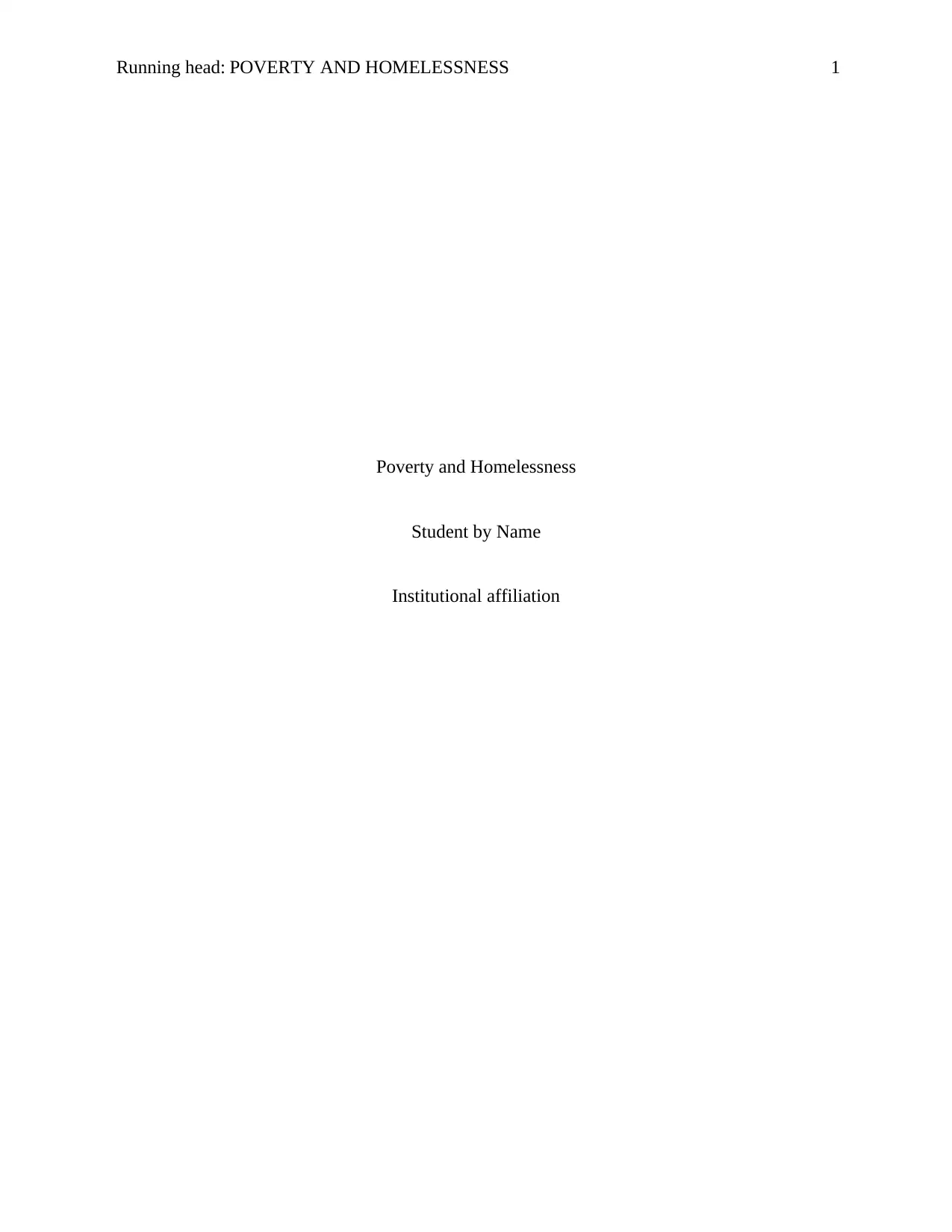
Running head: POVERTY AND HOMELESSNESS 1
Poverty and Homelessness
Student by Name
Institutional affiliation
Poverty and Homelessness
Student by Name
Institutional affiliation
Paraphrase This Document
Need a fresh take? Get an instant paraphrase of this document with our AI Paraphraser
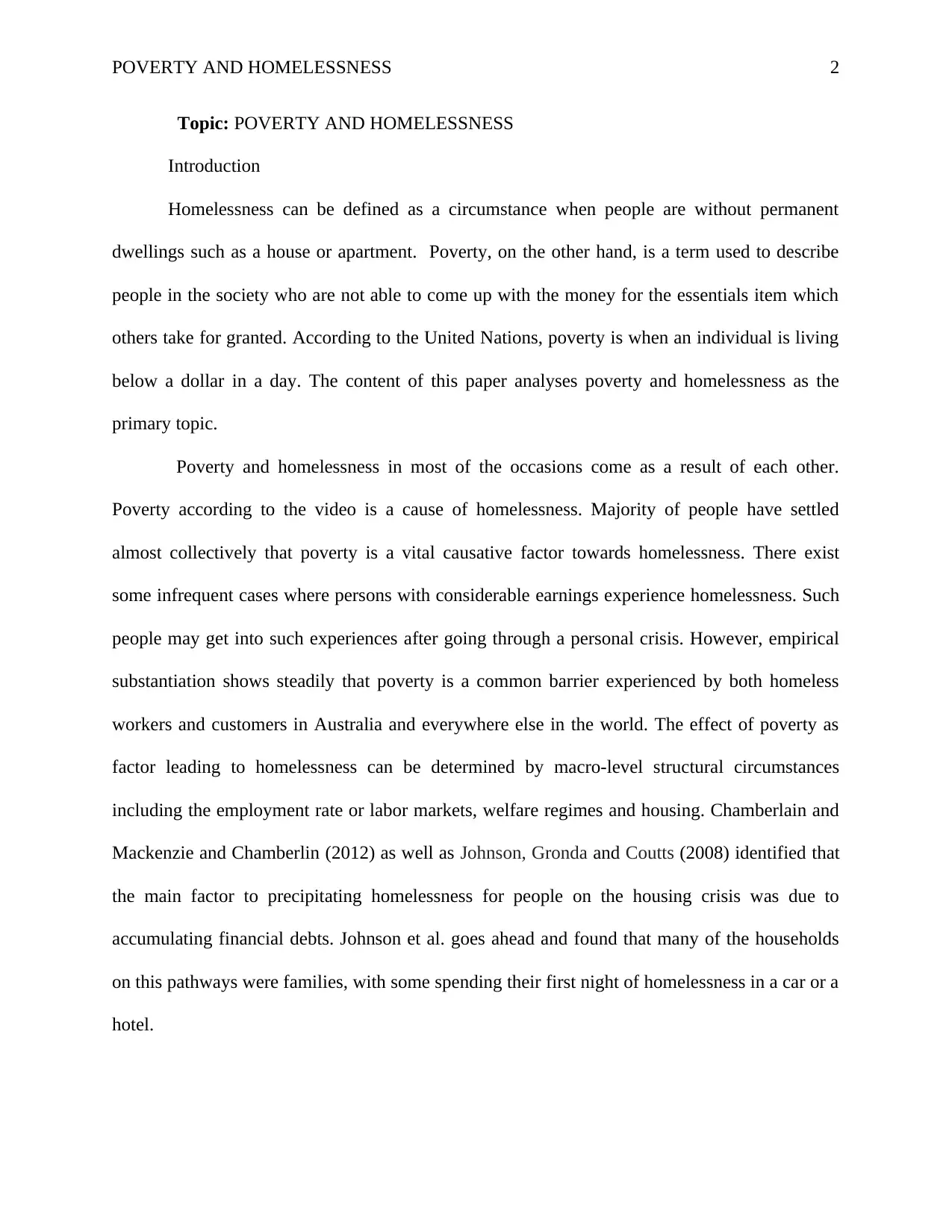
POVERTY AND HOMELESSNESS 2
Topic: POVERTY AND HOMELESSNESS
Introduction
Homelessness can be defined as a circumstance when people are without permanent
dwellings such as a house or apartment. Poverty, on the other hand, is a term used to describe
people in the society who are not able to come up with the money for the essentials item which
others take for granted. According to the United Nations, poverty is when an individual is living
below a dollar in a day. The content of this paper analyses poverty and homelessness as the
primary topic.
Poverty and homelessness in most of the occasions come as a result of each other.
Poverty according to the video is a cause of homelessness. Majority of people have settled
almost collectively that poverty is a vital causative factor towards homelessness. There exist
some infrequent cases where persons with considerable earnings experience homelessness. Such
people may get into such experiences after going through a personal crisis. However, empirical
substantiation shows steadily that poverty is a common barrier experienced by both homeless
workers and customers in Australia and everywhere else in the world. The effect of poverty as
factor leading to homelessness can be determined by macro-level structural circumstances
including the employment rate or labor markets, welfare regimes and housing. Chamberlain and
Mackenzie and Chamberlin (2012) as well as Johnson, Gronda and Coutts (2008) identified that
the main factor to precipitating homelessness for people on the housing crisis was due to
accumulating financial debts. Johnson et al. goes ahead and found that many of the households
on this pathways were families, with some spending their first night of homelessness in a car or a
hotel.
Topic: POVERTY AND HOMELESSNESS
Introduction
Homelessness can be defined as a circumstance when people are without permanent
dwellings such as a house or apartment. Poverty, on the other hand, is a term used to describe
people in the society who are not able to come up with the money for the essentials item which
others take for granted. According to the United Nations, poverty is when an individual is living
below a dollar in a day. The content of this paper analyses poverty and homelessness as the
primary topic.
Poverty and homelessness in most of the occasions come as a result of each other.
Poverty according to the video is a cause of homelessness. Majority of people have settled
almost collectively that poverty is a vital causative factor towards homelessness. There exist
some infrequent cases where persons with considerable earnings experience homelessness. Such
people may get into such experiences after going through a personal crisis. However, empirical
substantiation shows steadily that poverty is a common barrier experienced by both homeless
workers and customers in Australia and everywhere else in the world. The effect of poverty as
factor leading to homelessness can be determined by macro-level structural circumstances
including the employment rate or labor markets, welfare regimes and housing. Chamberlain and
Mackenzie and Chamberlin (2012) as well as Johnson, Gronda and Coutts (2008) identified that
the main factor to precipitating homelessness for people on the housing crisis was due to
accumulating financial debts. Johnson et al. goes ahead and found that many of the households
on this pathways were families, with some spending their first night of homelessness in a car or a
hotel.
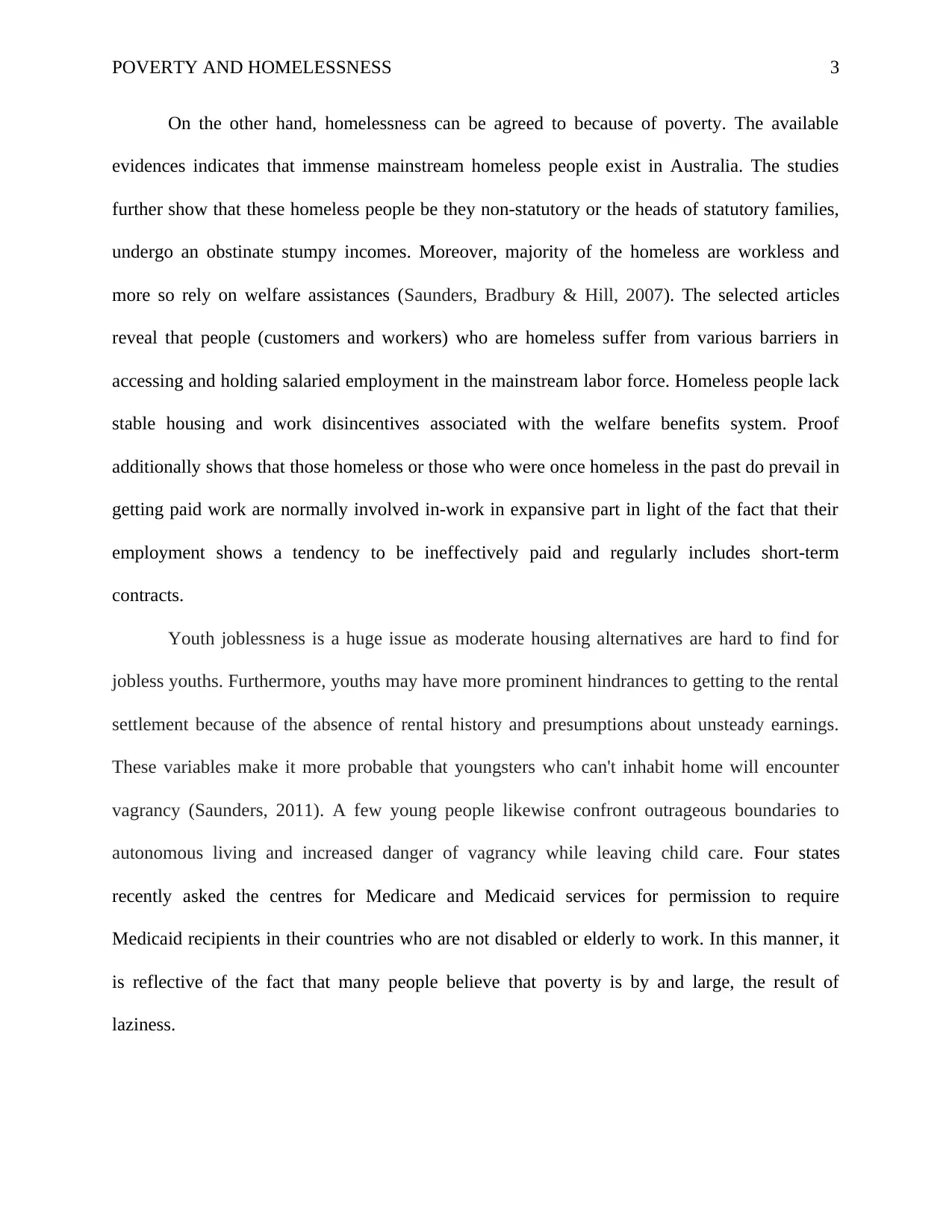
POVERTY AND HOMELESSNESS 3
On the other hand, homelessness can be agreed to because of poverty. The available
evidences indicates that immense mainstream homeless people exist in Australia. The studies
further show that these homeless people be they non-statutory or the heads of statutory families,
undergo an obstinate stumpy incomes. Moreover, majority of the homeless are workless and
more so rely on welfare assistances (Saunders, Bradbury & Hill, 2007). The selected articles
reveal that people (customers and workers) who are homeless suffer from various barriers in
accessing and holding salaried employment in the mainstream labor force. Homeless people lack
stable housing and work disincentives associated with the welfare benefits system. Proof
additionally shows that those homeless or those who were once homeless in the past do prevail in
getting paid work are normally involved in-work in expansive part in light of the fact that their
employment shows a tendency to be ineffectively paid and regularly includes short-term
contracts.
Youth joblessness is a huge issue as moderate housing alternatives are hard to find for
jobless youths. Furthermore, youths may have more prominent hindrances to getting to the rental
settlement because of the absence of rental history and presumptions about unsteady earnings.
These variables make it more probable that youngsters who can't inhabit home will encounter
vagrancy (Saunders, 2011). A few young people likewise confront outrageous boundaries to
autonomous living and increased danger of vagrancy while leaving child care. Four states
recently asked the centres for Medicare and Medicaid services for permission to require
Medicaid recipients in their countries who are not disabled or elderly to work. In this manner, it
is reflective of the fact that many people believe that poverty is by and large, the result of
laziness.
On the other hand, homelessness can be agreed to because of poverty. The available
evidences indicates that immense mainstream homeless people exist in Australia. The studies
further show that these homeless people be they non-statutory or the heads of statutory families,
undergo an obstinate stumpy incomes. Moreover, majority of the homeless are workless and
more so rely on welfare assistances (Saunders, Bradbury & Hill, 2007). The selected articles
reveal that people (customers and workers) who are homeless suffer from various barriers in
accessing and holding salaried employment in the mainstream labor force. Homeless people lack
stable housing and work disincentives associated with the welfare benefits system. Proof
additionally shows that those homeless or those who were once homeless in the past do prevail in
getting paid work are normally involved in-work in expansive part in light of the fact that their
employment shows a tendency to be ineffectively paid and regularly includes short-term
contracts.
Youth joblessness is a huge issue as moderate housing alternatives are hard to find for
jobless youths. Furthermore, youths may have more prominent hindrances to getting to the rental
settlement because of the absence of rental history and presumptions about unsteady earnings.
These variables make it more probable that youngsters who can't inhabit home will encounter
vagrancy (Saunders, 2011). A few young people likewise confront outrageous boundaries to
autonomous living and increased danger of vagrancy while leaving child care. Four states
recently asked the centres for Medicare and Medicaid services for permission to require
Medicaid recipients in their countries who are not disabled or elderly to work. In this manner, it
is reflective of the fact that many people believe that poverty is by and large, the result of
laziness.
⊘ This is a preview!⊘
Do you want full access?
Subscribe today to unlock all pages.

Trusted by 1+ million students worldwide
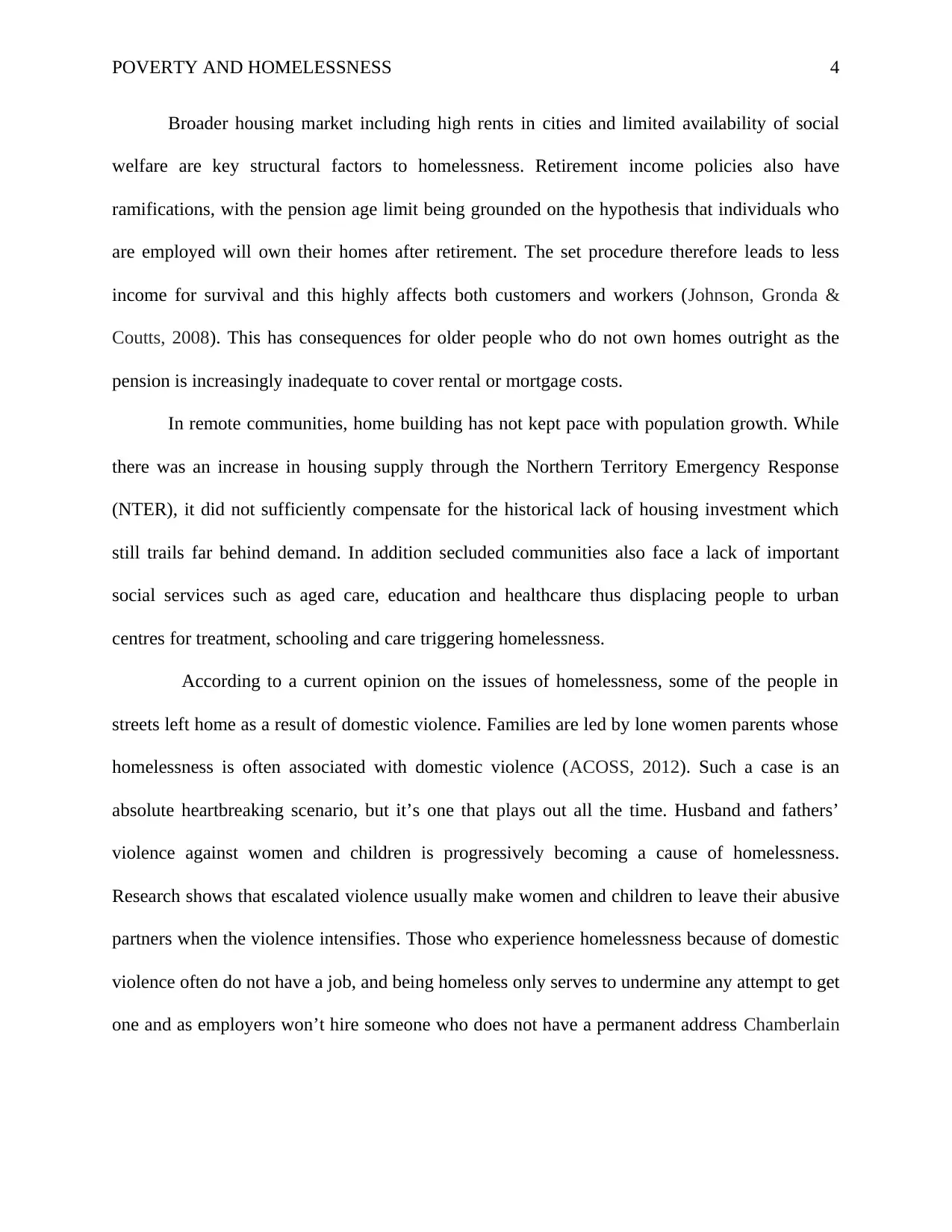
POVERTY AND HOMELESSNESS 4
Broader housing market including high rents in cities and limited availability of social
welfare are key structural factors to homelessness. Retirement income policies also have
ramifications, with the pension age limit being grounded on the hypothesis that individuals who
are employed will own their homes after retirement. The set procedure therefore leads to less
income for survival and this highly affects both customers and workers (Johnson, Gronda &
Coutts, 2008). This has consequences for older people who do not own homes outright as the
pension is increasingly inadequate to cover rental or mortgage costs.
In remote communities, home building has not kept pace with population growth. While
there was an increase in housing supply through the Northern Territory Emergency Response
(NTER), it did not sufficiently compensate for the historical lack of housing investment which
still trails far behind demand. In addition secluded communities also face a lack of important
social services such as aged care, education and healthcare thus displacing people to urban
centres for treatment, schooling and care triggering homelessness.
According to a current opinion on the issues of homelessness, some of the people in
streets left home as a result of domestic violence. Families are led by lone women parents whose
homelessness is often associated with domestic violence (ACOSS, 2012). Such a case is an
absolute heartbreaking scenario, but it’s one that plays out all the time. Husband and fathers’
violence against women and children is progressively becoming a cause of homelessness.
Research shows that escalated violence usually make women and children to leave their abusive
partners when the violence intensifies. Those who experience homelessness because of domestic
violence often do not have a job, and being homeless only serves to undermine any attempt to get
one and as employers won’t hire someone who does not have a permanent address Chamberlain
Broader housing market including high rents in cities and limited availability of social
welfare are key structural factors to homelessness. Retirement income policies also have
ramifications, with the pension age limit being grounded on the hypothesis that individuals who
are employed will own their homes after retirement. The set procedure therefore leads to less
income for survival and this highly affects both customers and workers (Johnson, Gronda &
Coutts, 2008). This has consequences for older people who do not own homes outright as the
pension is increasingly inadequate to cover rental or mortgage costs.
In remote communities, home building has not kept pace with population growth. While
there was an increase in housing supply through the Northern Territory Emergency Response
(NTER), it did not sufficiently compensate for the historical lack of housing investment which
still trails far behind demand. In addition secluded communities also face a lack of important
social services such as aged care, education and healthcare thus displacing people to urban
centres for treatment, schooling and care triggering homelessness.
According to a current opinion on the issues of homelessness, some of the people in
streets left home as a result of domestic violence. Families are led by lone women parents whose
homelessness is often associated with domestic violence (ACOSS, 2012). Such a case is an
absolute heartbreaking scenario, but it’s one that plays out all the time. Husband and fathers’
violence against women and children is progressively becoming a cause of homelessness.
Research shows that escalated violence usually make women and children to leave their abusive
partners when the violence intensifies. Those who experience homelessness because of domestic
violence often do not have a job, and being homeless only serves to undermine any attempt to get
one and as employers won’t hire someone who does not have a permanent address Chamberlain
Paraphrase This Document
Need a fresh take? Get an instant paraphrase of this document with our AI Paraphraser
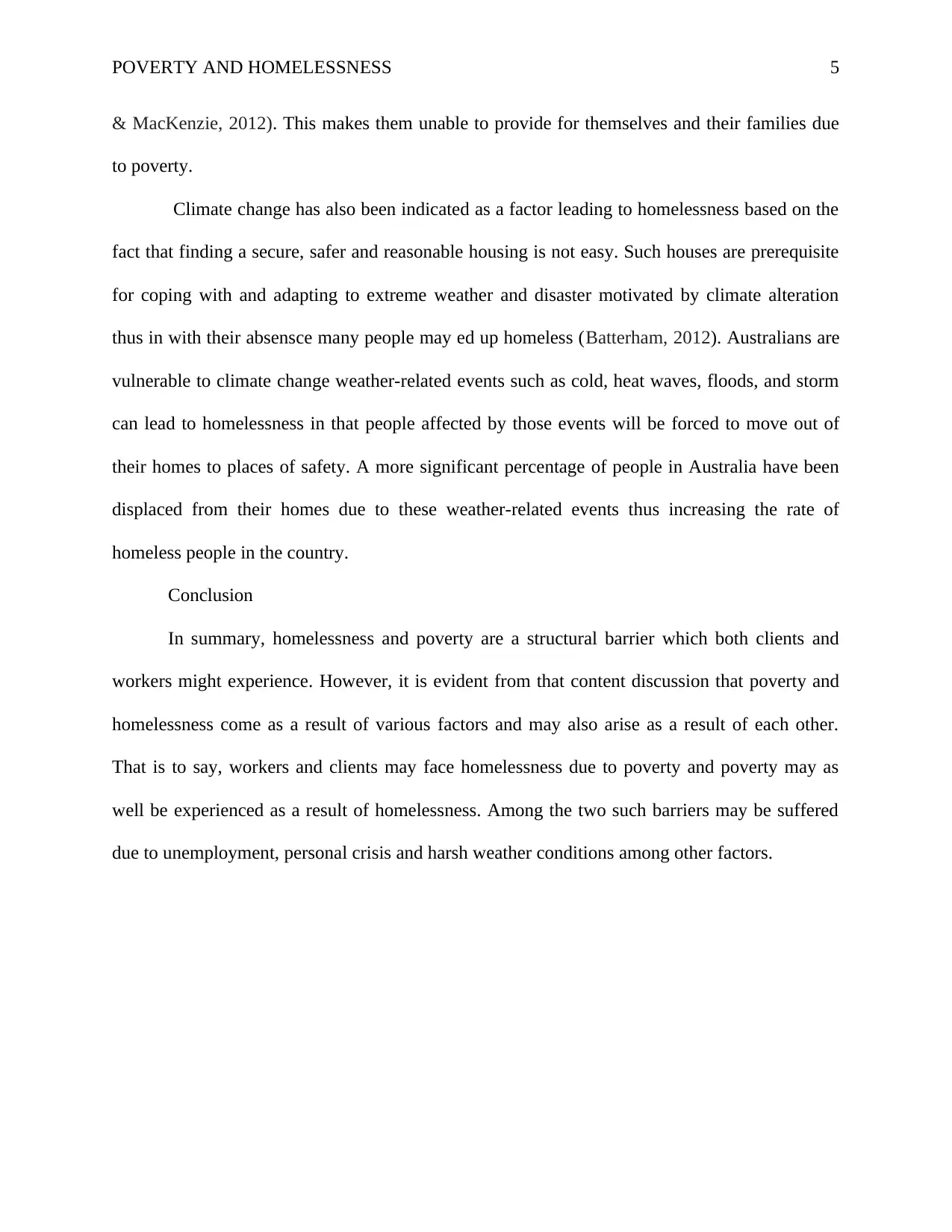
POVERTY AND HOMELESSNESS 5
& MacKenzie, 2012). This makes them unable to provide for themselves and their families due
to poverty.
Climate change has also been indicated as a factor leading to homelessness based on the
fact that finding a secure, safer and reasonable housing is not easy. Such houses are prerequisite
for coping with and adapting to extreme weather and disaster motivated by climate alteration
thus in with their absensce many people may ed up homeless (Batterham, 2012). Australians are
vulnerable to climate change weather-related events such as cold, heat waves, floods, and storm
can lead to homelessness in that people affected by those events will be forced to move out of
their homes to places of safety. A more significant percentage of people in Australia have been
displaced from their homes due to these weather-related events thus increasing the rate of
homeless people in the country.
Conclusion
In summary, homelessness and poverty are a structural barrier which both clients and
workers might experience. However, it is evident from that content discussion that poverty and
homelessness come as a result of various factors and may also arise as a result of each other.
That is to say, workers and clients may face homelessness due to poverty and poverty may as
well be experienced as a result of homelessness. Among the two such barriers may be suffered
due to unemployment, personal crisis and harsh weather conditions among other factors.
& MacKenzie, 2012). This makes them unable to provide for themselves and their families due
to poverty.
Climate change has also been indicated as a factor leading to homelessness based on the
fact that finding a secure, safer and reasonable housing is not easy. Such houses are prerequisite
for coping with and adapting to extreme weather and disaster motivated by climate alteration
thus in with their absensce many people may ed up homeless (Batterham, 2012). Australians are
vulnerable to climate change weather-related events such as cold, heat waves, floods, and storm
can lead to homelessness in that people affected by those events will be forced to move out of
their homes to places of safety. A more significant percentage of people in Australia have been
displaced from their homes due to these weather-related events thus increasing the rate of
homeless people in the country.
Conclusion
In summary, homelessness and poverty are a structural barrier which both clients and
workers might experience. However, it is evident from that content discussion that poverty and
homelessness come as a result of various factors and may also arise as a result of each other.
That is to say, workers and clients may face homelessness due to poverty and poverty may as
well be experienced as a result of homelessness. Among the two such barriers may be suffered
due to unemployment, personal crisis and harsh weather conditions among other factors.
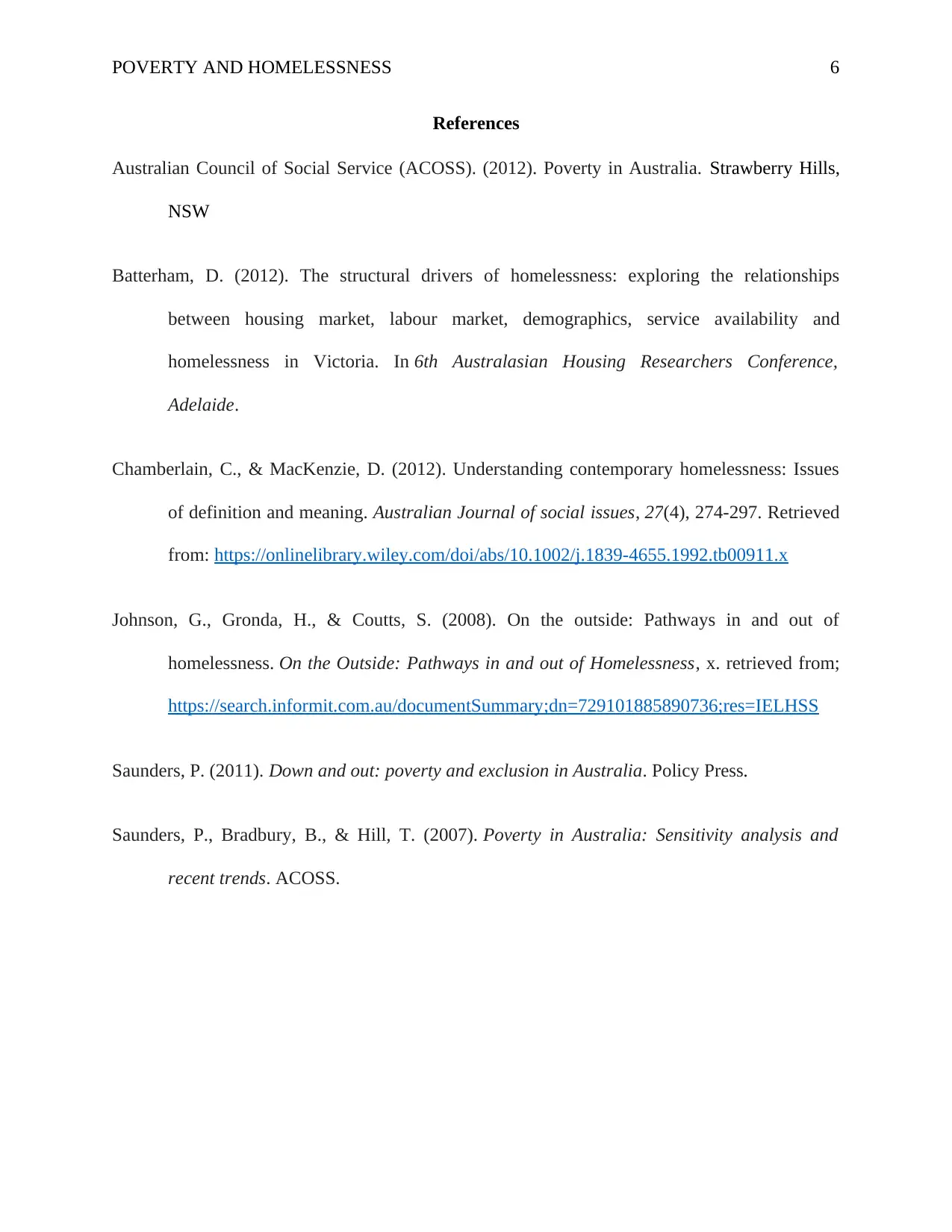
POVERTY AND HOMELESSNESS 6
References
Australian Council of Social Service (ACOSS). (2012). Poverty in Australia. Strawberry Hills,
NSW
Batterham, D. (2012). The structural drivers of homelessness: exploring the relationships
between housing market, labour market, demographics, service availability and
homelessness in Victoria. In 6th Australasian Housing Researchers Conference,
Adelaide.
Chamberlain, C., & MacKenzie, D. (2012). Understanding contemporary homelessness: Issues
of definition and meaning. Australian Journal of social issues, 27(4), 274-297. Retrieved
from: https://onlinelibrary.wiley.com/doi/abs/10.1002/j.1839-4655.1992.tb00911.x
Johnson, G., Gronda, H., & Coutts, S. (2008). On the outside: Pathways in and out of
homelessness. On the Outside: Pathways in and out of Homelessness, x. retrieved from;
https://search.informit.com.au/documentSummary;dn=729101885890736;res=IELHSS
Saunders, P. (2011). Down and out: poverty and exclusion in Australia. Policy Press.
Saunders, P., Bradbury, B., & Hill, T. (2007). Poverty in Australia: Sensitivity analysis and
recent trends. ACOSS.
References
Australian Council of Social Service (ACOSS). (2012). Poverty in Australia. Strawberry Hills,
NSW
Batterham, D. (2012). The structural drivers of homelessness: exploring the relationships
between housing market, labour market, demographics, service availability and
homelessness in Victoria. In 6th Australasian Housing Researchers Conference,
Adelaide.
Chamberlain, C., & MacKenzie, D. (2012). Understanding contemporary homelessness: Issues
of definition and meaning. Australian Journal of social issues, 27(4), 274-297. Retrieved
from: https://onlinelibrary.wiley.com/doi/abs/10.1002/j.1839-4655.1992.tb00911.x
Johnson, G., Gronda, H., & Coutts, S. (2008). On the outside: Pathways in and out of
homelessness. On the Outside: Pathways in and out of Homelessness, x. retrieved from;
https://search.informit.com.au/documentSummary;dn=729101885890736;res=IELHSS
Saunders, P. (2011). Down and out: poverty and exclusion in Australia. Policy Press.
Saunders, P., Bradbury, B., & Hill, T. (2007). Poverty in Australia: Sensitivity analysis and
recent trends. ACOSS.
⊘ This is a preview!⊘
Do you want full access?
Subscribe today to unlock all pages.

Trusted by 1+ million students worldwide
1 out of 6
Your All-in-One AI-Powered Toolkit for Academic Success.
+13062052269
info@desklib.com
Available 24*7 on WhatsApp / Email
![[object Object]](/_next/static/media/star-bottom.7253800d.svg)
Unlock your academic potential
Copyright © 2020–2025 A2Z Services. All Rights Reserved. Developed and managed by ZUCOL.


